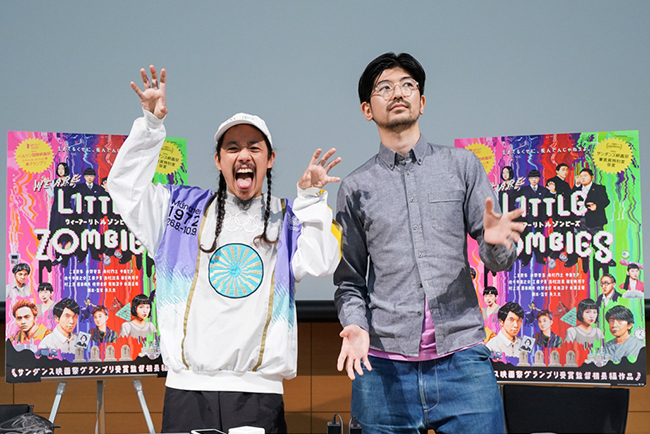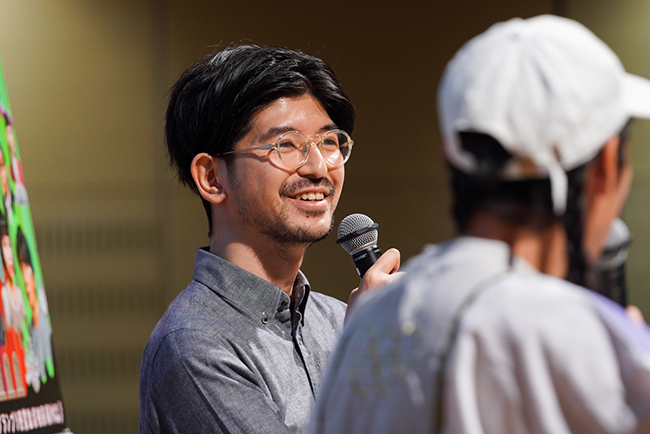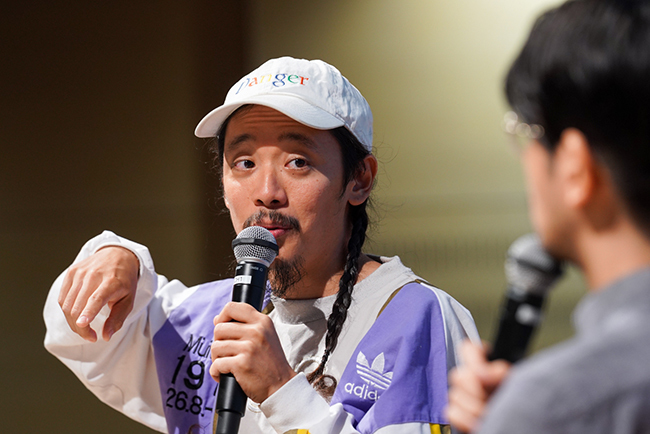The acclaimed coming-of-age musical film "We Are Little Zombies," which has garnered numerous awards at prestigious international film festivals, celebrated its Japanese release. To mark this occasion, a talk event featuring director Masashi Nagahisa and his close friend and Dentsu Inc. colleague Yusuke Sato was held on June 3 at Dentsu Hall in Shiodome, Tokyo.
*This talk event was held on June 3, prior to the film's Japanese release.
The two once submitted a joint entry to Young Cannes and even produced commercials as a double planner team. These two contrasting creators discuss the appeal of filmmaking using advertising techniques and their approaches to film and commercials.
※The film " We Are Little Zombies " is now showing in theaters nationwide starting June 14!
※This article is a recompilation of content from the event "Dentsu Design Talk Vol.183: Screening & Commemorative Talk for Director Atsushi Nagaku's 'We Are Little Zombies' - Advertising and Film: Sometimes They Fight, Sometimes They Get Along."

(From left) Dentsu Inc.'s Masamune Nagahisa and Yusuke Sato
This Tempo All the Way Through!? The Sound Storyboard Was Key
Nagaku: My feature debut, "We Are Little Zombies," opens on June 14th. I imagine there are various ways to interpret it, but what did you think, Sato-kun?
Sato: Actually, this is my third time seeing it, and my impressions change each time. The first time, it felt like a modern, digital pop version of Shunji Iwai's "Swallowtail," and the music really stuck with me—the tempo was fascinating.
And today, on my third viewing, I felt it shared something with Hideaki Anno's Shin Godzilla. Both works are incredibly meticulous in their attention to detail.
Nagaku: Ah, that's great. Being compared to Anno-san is a real compliment. This film was made under the rule that not a single detail could be overlooked, not a single shot could be taken lightly, so I imagine it was tough on the staff. We even directed every last corner of the website and pamphlets.
Sato: I really love "Shin Godzilla." It also has a lot of dialogue, and it's built on the tempo, the lines, and the aesthetics of the framing that captures them.
Nagaku: I was truly obsessed with the tempo. The traditional way of making films involves actors rehearsing their lines within the set, then shooting angles tailored to their performances. But I start by reading the entire script myself, acting out the lines, and adding a rough musical score to create a two-hour video storyboard. It's like a video storyboard for commercials, where I decide every single cut beforehand.
By preparing this beforehand, I ensure the tempo of the sound I want and the visual rhythm of the cuts remain consistent on the actual set. Incidentally, deciding the shot breakdown in advance also has the advantage of not needing to build the entire set. Like, "Oh, we only need a 30-degree angle here" (laughs).
Sato: Ah, so that's how you work. I saw the making-of for "Shin Godzilla," and they had this massive script volume where you'd think, "There's no way this will fit into two hours!" But they completed a two-hour audio-only storyboard first, saying, "No, if we keep this tempo, it will absolutely fit!" So there really are commonalities in your approach.
Nagaku: My script is also really thick. I was told, "No way, this is three hours' worth of text."
Sato: First-time viewers probably think, "There's no way they're going to keep this pace for two hours," within the first 15 minutes. Then, around the one-hour mark, they realize, "Oh, this guy really is going to keep this up" (laugh). And then that song plays midway through, creating this huge catharsis moment.
Nagaku: It's a band story, yet they don't form the band for the first hour. It's a bit too much teasing, but establishing those kids' backstories solidly in the first half was my core principle.
Sato: It builds up at that steady pace, and that song scene feels so satisfying. Nagahisa-kun, your roots are in music, right? You play an instrument.
Nagaku: I played saxophone in a jazz band for a long time.
Sato: That's why your sense of sound really shines through. Come to think of it, when we traveled to Bhutan together years ago, you played some mysterious Bhutanese instrument and instantly became friends with the locals. I was so jealous, or rather, I thought it was really cool.
Nagaku: Thank you. I believe sound is a better switch for influencing people's emotions than visuals. In film, I feel like the impression created by sound and detail is practically everything.
Sato: Since this film's theme is children losing their emotions, their acting is flat. But the music becomes joyful or sad, so I watched thinking, "Is their inner world being expressed through the music?"
Nagaku: Exactly. I wanted to show that emotional fluctuations exist, so I incorporated a lot of music.
A "Sense of Mission" Born from Daily Life as the Source of Creation
Sato: Nagaku-kun, where do you start when making a film? For example, with this one, did you begin with the theme, or did you start from wanting to make a music-focused piece?
Nagaku: I started this film after learning about the "Blue Whale" game—a social media challenge originating in Russia—that brainwashes children and drives them to suicide. I saw it on the news about two years ago and was deeply shocked.
So, presumptuous as it may be, I felt a sense of mission: by portraying children who maintain humor and a nihilistic gaze even in desperate situations, I might offer some solace or lighten the mood for people facing similar circumstances. That was the starting point. From there, I wrote the entire script in one go over the course of a month.
Sato: That was true of your previous work , " And So We Put Goldfish in the Pool, " too. Something real happens, and you start writing the script driven by a sense of mission about it.
Nagaku: Back then too, I was driven by this self-appointed sense of mission, this feeling I had to speak for them. But when it comes to writing stories, I can only do it by carving out my own experiences and emotions. This time, Hikari-kun is basically my childhood self. How do other film directors write their screenplays?
Sato: Come to think of it, I feel like there aren't many original screenplays in Japanese cinema. Or is that not the case?
Nagaku: Original screenplays without source material do tend to be harder to make viable as a business. Plus, with a cast of relatively unknown actors like in this film, I imagine investors were hesitant. But this time, we convinced them by designing a promotional strategy that addressed those concerns—my background in advertising really came into play.
Sato: I see. So Nagahisa-kun is also handling film promotion design now. I thought it was interesting that you actually ran ads for a fictional band.
Nagaku: Exactly. When we released the music video segment from the film on YouTube, people started genuinely debating things like, "This singer is pretty bad, right?" (laughs). The band actually debuted through Sony Music, and the theme song is available on various streaming services. We also released a novelization covering things the film couldn't fully explore.
Sato: That kind of approach is very creative director-like, isn't it?
Nagaku: I made the film itself while channeling my 13-year-old self, then after production, as an advertising pro, I thought, "Man, this is a tough movie to sell!" and figured out how to handle it. When the same person is involved that deeply, the direction never wavers.
Sato: Regarding casting, the main four are "known to those in the know," and the adult cast is incredibly luxurious, or rather, it's for connoisseurs. What was your intention behind the casting?
Nagaku: My taste in acting is pretty narrow, so I didn't compromise—I asked exactly who I wanted. When I wrote the script, I already had my ideal cast in mind. Even though the budget wasn't huge, I approached them saying, "If you like it, please join us." The only one I knew personally was CHAI. And then, well, because of how I look, people were like, "Oh, this is just some ad guy's whimsical project, right?"...
Sato: Ah, so there was that one filter in place.
Nagaku: That's why it meant so much to me that overseas film festivals like Sundance and Berlin, where there's no such filter, evaluated the film purely on its own merits.
I want to create "stories" through film and advertising.

Sato: Earlier, you mentioned how your advertising experience helps with film promotion. Are there areas where you feel it helps with filmmaking itself?
Nagaku: Absolutely! For about ten years, I made around 100 in-store videos annually for a major retail chain. In-store videos are brutal—you have to get people who aren't interested to stop and watch. It's an extremely challenging environment.
That experience ingrained techniques for organizing overwhelming information, methods for grabbing attention with sound, and the constant need to keep things fresh with the right pacing. I genuinely think making those videos was a great thing.
Sato: I saw the films Nagahisa-kun made in college, and honestly, I think he's changed a lot as a creator now. He's developed a way to make people who aren't interested stop and watch. I always thought of Nagahisa-kun as someone who made tons of commercials. That's where he differs from me. I was more of a one-shot-wonder type.
Also, I remember thinking at Young Cannes that Nagahisa really came alive when editing footage or obsessing over details. I thought I was better suited for commercial planning, but Nagahisa excelled at crafting those details. That's how our paths gradually diverged.
Nagaku: Maybe I just wasn't cut out for advertising. Sato, what do you think about when you create ads? I always thought you were incredibly skilled at tone control.
Sato: I create by thinking about the aftertaste—what kind of sizzle that product or brand should have. I thoroughly consider what kind of atmosphere that product should embody in today's era before creating. I guess that's what becomes the tone control.
Nagaku: I see... When I plan ads, I inevitably end up just explaining the product. Even when I have something I want to convey about the product, I get too caught up seriously wondering if turning it into the story I want to tell is wrong. In that sense, your work, Sato-kun, has entertainment value. It feels like you're providing an "amusement park" that even people uninterested in the product can enjoy.
Sato: That's because those were the things I loved as a student. About ten years ago, I also felt it was difficult to create a story within a single commercial. Back then, as a CM planner, I wondered, "What exactly is a creative director?" But now I've come to understand the appeal.
I eventually realized it's hard to cram all advertising expression into a single commercial. But as a creative director, when I started designing campaigns encompassing things like web and events, I no longer needed to solve everything with just the commercial. As a result, the constraints lifted, and I think I'm now building commercials from the ground up.
Nagaku: I get it. But I still love film, so I wanted to create stories as a filmmaker. When I hit a wall in advertising production, I took paid leave and personally shot "And So We Put Goldfish in the Pool."
Sato: Nagahisa, you've always said you wanted to make movies. At your wedding, you handed out films you made back in your student days, right? If you want to tell a story, it definitely feels like a longer-form film is better than an ad.
Nagaku: Exactly. Plus, I have this desire to validate people who think they're no good or have given up. Characters with that kind of negative outlook don't really get to appear in ads, do they? I started feeling a sense of mission in life to validate those things.
Sato: I see. That's a pretty rare type of person, isn't it?
Nagaku: But people who work in advertising professionally definitely have unique ways of thinking and skills for creating content. I'm not very good at that part, so I think there are plenty of people who are better than me.
If anyone in the company is interested in film, I'd love to hear from them. Maybe we could figure out how to make a movie together. For example, I think it'd be interesting if you, Sato-kun, made a film. Thank you so much for today!
Official Website for the Film "We Are Little Zombies"
https://littlezombies.jp/










